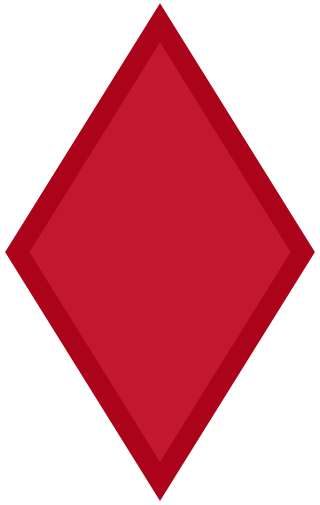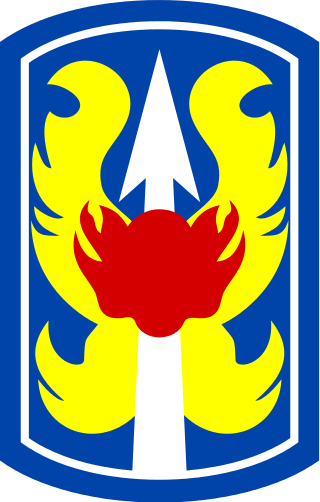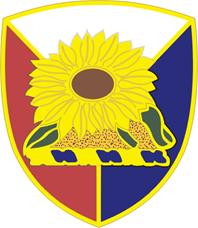
The 4th Infantry Division is a division of the United States Army based at Fort Carson, Colorado. It is composed of a division headquarters battalion, three brigade combat teams, a combat aviation brigade, a division sustainment brigade, and a division artillery.

The 5th Infantry Division (Mechanized)—nicknamed the "Red Diamond", or the "Red Devils" —was an infantry division of the United States Army that served in World War I, World War II and the Vietnam War, and with NATO and the U.S. Army III Corps. It was inactivated on 24 November 1992 and reflagged as the 2nd Armored Division.

The 35th Infantry Division, formerly known as the 35th Division, is an infantry formation of the United States Army National Guard headquartered at Fort Leavenworth, Kansas.

The 43rd Infantry Division was a formation of the United States Army from 1920 to 1963, serving in the Pacific during World War II. It was activated in 1920 as a National Guard Division in Connecticut, Maine, Rhode Island, and Vermont. The 143rd Regional Support Group of the Connecticut National Guard now carries on the heritage.

The 9th Infantry Division is an inactive infantry division of the United States Army. It was created as the 9th Division during World War I, but never deployed overseas. In later years it was an important unit of the U.S. Army during World War II and the Vietnam War. It was also activated as a peacetime readiness unit from 1947 to 1962 at Fort Dix, New Jersey, and Fort Carson, Colorado, and from 1972 to 1991 as an active-duty infantry division at Fort Lewis, Washington. The division was deactivated in December 1991.

The 6th Infantry Division was an infantry division of the United States Army active in World War I, World War II, and the last years of the Cold War. Known as "Red Star", it was previously called the "Sight Seein' Sixth".

The 2nd Cavalry Division was a cavalry division of the United States Army.

The 199th Infantry Brigade (Light) is a unit of the United States Army which served in the Army Reserve from 1921 to 1940, in the active army from 1966 to 1970 (serving in the Vietnam War), briefly in 1991–1992 at Fort Lewis, and from 2007 as an active army training formation at Fort Moore.

The Kansas Army National Guard is a component of the Army National Guard and the Kansas National Guard. Kansas Army National Guard units are trained and equipped as part of the United States Army. The same ranks and insignia are used and National Guardsmen are eligible to receive all United States military awards. The Kansas Guard also bestows a number of state awards for local services rendered in or to the state of Kansas. It is, along with the Kansas Air National Guard, an element of the Kansas National Guard.

The 11th Infantry Brigade is an inactive infantry brigade of the United States Army. It was first formed as part of the 6th Division during World War I. It is best known for its service with the 23rd Infantry Division from 1967 through 1971 in the Vietnam War as a light infantry brigade. The brigade is known for its responsibility in the My Lai Massacre.

The 191st Infantry Brigade was constituted on 24 June 1921 in the Organized Reserves as Headquarters and Headquarters Company, 191st Infantry Brigade, and assigned to the 96th Division. It was organized in December 1921 at Portland, Oregon, and redesignated on 23 March 1925 as Headquarters and Headquarters Company, 191st Brigade, then redesignated on 24 August 1936 as Headquarters and Headquarters Company, 191st Infantry Brigade. It was converted and redesignated on 6 April 1942 as the 96th Reconnaissance Troop, 96th Division. The Troop was ordered into active military service on 15 August 1942 and reorganized at Camp Adair, Oregon, as the 96th Cavalry Reconnaissance Troop, an element of the 96th Infantry Division. It was reorganized and redesignated on 16 August 1943 as the 96th Reconnaissance Troop, Mechanized, and then again reorganized and redesignated on 20 November 1945 as the 96th Mechanized Cavalry Reconnaissance Troop. Following World War II service with the 96th Infantry Division in the Pacific, it was inactivated on 3 February 1946 at Camp Anza, California.

The 157th Infantry Brigade is an active/reserve component (AC/RC) unit based at Camp Atterbury, Indiana. The unit is responsible for training selected United States Army Reserve and National Guard units. The unit was activated using the assets of the 5th Brigade, 87th Division. The brigade is a subordinate unit of First Army Division East.

The 67th Maneuver Enhancement Brigade is a maneuver enhancement brigade (MEB) of the Nebraska Army National Guard. It derives its lineage from the 67th Infantry Brigade (Mechanized), previously a component of the 35th Infantry Division (Mechanized). The brigade has also been organized as an area support group from 2003–2008, and as a battlefield surveillance brigade from 2008–2016.

The 197th Infantry Brigade is an active Infantry brigade of the United States Army. The brigade was active as an Organized Reserve unit from 1921–1942, in the Regular Army from 1962–1991, and as a TRADOC training unit from 2007–2013. The brigade saw service in Operation Desert Storm with the 24th Infantry Division. On July 31st, 2020 the Brigade was activated as a Training Brigade in Fort Moore, GA to serve the increased training needs of the Army.

The 168th Field Artillery Regiment was a Field Artillery Branch regiment of the Army National Guard.

The 1st Battalion, 161st Field Artillery Regiment is a Field Artillery battalion of the Kansas Army National Guard in Kansas. Like many National Guard field artillery battalions, it is the sole battalion in the regiment. The battalion is currently headquartered in Hutchinson, and consists of three firing batteries: Alpha, Bravo (Abilene), Charlie (Newton), and a Headquarters Battery (Hutchinson). The battalion has a direct support relationship with the 1161st Forward Support Company. The battalion's higher headquarters is the 130th Field Artillery Brigade (Manhattan).

The 149th Maneuver Enhancement Brigade is a maneuver enhancement brigade of the Kentucky Army National Guard, headquartered at Richmond.
The 4th Brigade Combat Team, 4th Infantry Division is an inactive brigade of the United States Army. Between 1975 and 1984, the brigade served at Fort Carson, CO, and in Germany. The brigade was reactivated in 2004, and deployed four times in support of the War on Terror, once to Iraq and three times to Afghanistan, before being inactivated in 2015.

The 137th Infantry Regiment was an infantry regiment of the United States Army. It was part of the Kansas Army National Guard and has served with distinction in the Philippine Insurrection, World War I, and World War II. The last active battalion was the 2nd Battalion, as the 2–137th Combined Arms Battalion, a component of the 635th Regional Support Group. The battalion was redesignated as the 1st Battalion, 635th Armor Regiment in 2020, although the structure of the unit remained unchanged.


















